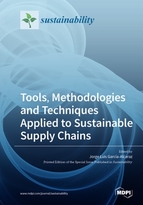Tools, Methodologies and Techniques Applied to Sustainable Supply Chains
A special issue of Sustainability (ISSN 2071-1050).
Deadline for manuscript submissions: closed (31 October 2019) | Viewed by 75941
Special Issue Editor
Interests: lean manufacturing; supply chain optimization; lean supply chain; sustainable supply chain; environmental impact
Special Issues, Collections and Topics in MDPI journals
Special Issue Information
Dear Colleagues,
Supply Chains and production systems, nowadays, are globalized and are distributed geographically around the world, since currently it is possible that, for a product, the raw materials are extracted in a country, processed in a second country, assembled or converted into final product in a third and distributed and marketed in other countries (Jean, Kim, and Bello, 2017). Some authors indicate that, for some products, 60% of the total cost thereof is associated with supply chain and logistics (Wang, Guo, Yan, and Wang, 2018). This Special Issue is aimed to identify different, tools, methodologies and techniques that managers are managing to improve supply chain sustainability and that allow them to generate a competitive advantage to keep their company in the globalized market with low-cost products and being a socially responsible company.
All the selected papers must help to understand the application of tools, methodologies and techniques in the supply chain, illustrating how managers are focused on cost reduction, partner integration, use of information and communication technologies, algorithms that seek to optimize resources, human resources involvement, information flow among partners, etc. The examples can come from sectors such as automotive, aerospace, agricultural, healthcare, tourism, mining, forest, to mention a few. The Special Issue is open to receive theoretical, case studies and real-world contributions in different topics and aspects related with supply chain sustainability.
References:
Jean, R. J. B., Kim, D., & Bello, D. C. (2017). Relationship-based product innovations: Evidence from the global supply chain. Journal of Business Research, 80, 127-140. doi:https://0-doi-org.brum.beds.ac.uk/10.1016/j.jbusres.2017.07.008
Wang, X., Guo, H., Yan, R., & Wang, X. (2018). Achieving optimal performance of supply chain under cost information asymmetry. Applied Mathematical Modelling, 53, 523-539. doi:https://0-doi-org.brum.beds.ac.uk/10.1016/j.apm.2017.09.002
Prof. Jorge Luis García Alcaraz
Guest Editor
Manuscript Submission Information
Manuscripts should be submitted online at www.mdpi.com by registering and logging in to this website. Once you are registered, click here to go to the submission form. Manuscripts can be submitted until the deadline. All submissions that pass pre-check are peer-reviewed. Accepted papers will be published continuously in the journal (as soon as accepted) and will be listed together on the special issue website. Research articles, review articles as well as short communications are invited. For planned papers, a title and short abstract (about 100 words) can be sent to the Editorial Office for announcement on this website.
Submitted manuscripts should not have been published previously, nor be under consideration for publication elsewhere (except conference proceedings papers). All manuscripts are thoroughly refereed through a single-blind peer-review process. A guide for authors and other relevant information for submission of manuscripts is available on the Instructions for Authors page. Sustainability is an international peer-reviewed open access semimonthly journal published by MDPI.
Please visit the Instructions for Authors page before submitting a manuscript. The Article Processing Charge (APC) for publication in this open access journal is 2400 CHF (Swiss Francs). Submitted papers should be well formatted and use good English. Authors may use MDPI's English editing service prior to publication or during author revisions.
Keywords
- Green supplier selection problem and relationship
- Reverse logistics and collection of used products
- Optimal plant location
- Routes optimization
- Infrastructure for procurement and distribution
- Software in sustainable supply chain
- Software and hardware integration in supply chain
- 100% open platform for supply chain
- Techniques and methodologies for sustainable production
- ICT in Sustainable supply chain
- Government regulations in supply chain
- Risk with hazardous materials
- Green procurement
- Green layout
- Green production process
- Green distribution






